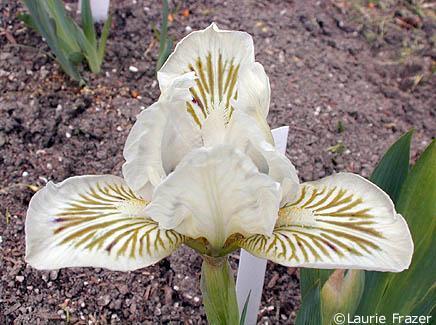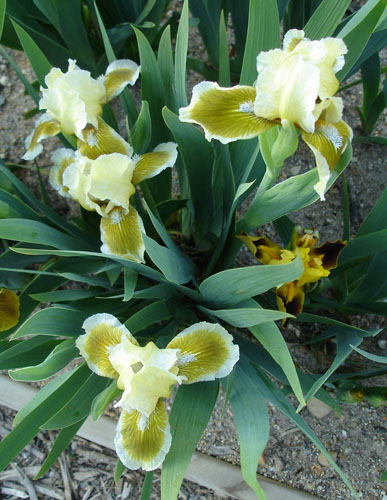Here's what Wikipedia says about the phrase "It isn't easy being green":
"Bein' Green" (also known as "Green") is a popular song written by Joe Raposo, originally performed by the Muppets and then covered by Frank Sinatra and other performers.
"In the Muppets version, Kermit begins by lamenting his green coloration, expressing that green 'blends in with so many ordinary things' and wishing to be some other color. But by the end of the song, Kermit recalls positive associations with the color green, and concludes by accepting and embracing his greenness."
Well, that may be okay if you're a faux frog, but if you're an iris, you're going to be judged, and must stand or fall on your own merits.
So, recently, I asked some Facebook friends to send me photos of irises which they considered to be, wholly or in part, green. To these I added a number of others that I dredged up from various sources, including my own garden. In order to make some sense of the results, I have, utterly arbitrarily, grouped them into the following various categories: Veins, Chartreuse, Olive, Plicata, Green Ground, Blue/green, Green Gone Wild and "?" Some, particularly the blue/green, could be (and are) found in more than one category. And I don't anticipate that everyone (anyone?) will agree with the categories into which I have put the several cultivars. As the title says, it ain't easy.
I am much indebted to our friends who responded, and I hope I haven't overlooked any contributions. There were several more submitted than are shown here, but both time and space have limited what I could include.
Please also bear in mind that some of the seedlings shown here are selected not for their beauty, but for their "greenery". So, let's begin.
Category: Veins
It was soon apparent that many irises are given the monicker "green" because of the veins in the falls.
The first responder to my call for folks to suggest green irises was Coro Martin, who is enamoured of 'Snow Tree's' veins.
 |
| SDB 'Snow Tree' -- R. Sobek. Photo by Laurie Frazer |
After that, things got both
greener and less green. Tom Waters
suggested P. Cook's 'Green Spot'.
 |
| IB 'Greenspot' -- P. Cook. Photo by Jensen |
Loic Tasquier contributed his seedling B018N:
and his seedling C050H:
Seedling 05M1 comes from my garden.


Here, again, we see 'Greenback Kid':


 |
| Tasquier sdlg B018N |
 |
| Tasquier sdlg C050H |
Crump MDB sdlg 05M1
Don Spoon's 'Greenback Kid' has what I would call olive veins on a chartreuse or light green ground.
SDB 'Greenback Kid' -- D. Spoon
'Green and Gifted' has olive veins on what appears to be a pale yellow-green ground. Here is its description in the Iris Register: "S. greenish champagne cream; F. overlaid blue when fresh, fading to S. color . . ."
TB 'Green and Gifted' -- P. Blyth
My SDB 'Greenwinkle' will be introduced in 2013.
SDB 'Greenwinkle' -- Crump
Then, there are some of my assorted green-veined seedlings, including:
Crump BB Sdlg 07P6 RE

SDB 'Conundrum' -- Chapman

Crump SDB sdlg 07H1
Almost needing a category of its own, this is Chuck Chapman's 'Conundrum':
SDB 'Conundrum' -- Chapman
Finally, it may take looking quite closely, or zooming the picture if you can, but this seedling, 07H1, had both true green veins and aqua veins. Unfortunately, it contracted rot and was lost. I'll be making this cross again:

Crump SDB sdlg 07H1
Category: Chartreuse
In the foregoing, we have seen that many irises are termed "green" because of the influence of the veining in their falls. Now, we turn to flowers whose overall coloring is termed green, but which is, in my opinion, really chartreuse.
The first of these is Loic Tasquier's Seedling B 114B (and notice the green veins):
 | |||||||
| Tasquier sdlg B 114B |
Then, Linda Mann suggested 'Green-Eyed Lady':
| TB 'Green-Eyed Lady' -- G. Plough. Photo by BlueJIris |
Not, I think, much greener than my 'Maid of Orleans', which I consider to be a very light chartreuse:
 |
| TB 'Maid of Orleans' -- Crump |
SDB 'Greenback Kid' -- D. Spoon
Then, 'County Cork':

TB 'County Cork' -- Schreiner, R.

Chapman Sdlg 94-234-1

SDB 'Green Gizmo' -- Chapman

SDB 'Lookout Sunshine' -- Chapman

From Winterberry Gardens comes 'Granny Apple':
 SDB (?) 'Granny Apple' -- D. Spoon
SDB (?) 'Granny Apple' -- D. Spoon

Crump SDB seedling 093I21
Chuck Chapman offered this bright seedling:
Chapman Sdlg 94-234-1
and his 'Green Gizmo':
SDB 'Green Gizmo' -- Chapman
as well as his 'Lookout Sunshine':
SDB 'Lookout Sunshine' -- Chapman
And his 'Wee Granny Smith' has plenty of green in it:
SDB 'Wee Granny Smith' -- Chapman
From Winterberry Gardens comes 'Granny Apple':
 SDB (?) 'Granny Apple' -- D. Spoon
SDB (?) 'Granny Apple' -- D. Spoon
Here is my seedling 07H10:
Crump SDB sdlg 07H10
and another seedling from my garden, 093I21:

Crump SDB seedling 093I21
Olive
I have grouped in this category those irises which, to my eye, appear to be various shades of olive.
The first of these, suggested by Lucy Burton, is 'Gecko Echo':
| MDB 'Gecko Echo' -- Kasperek |
Loic Tasquier's 'Caonach' (pronounced KWEE-nock), which is Irish for 'moss'.
SDB 'Moss Spot' -- D. Spoon
Then, several seedlings of my own, starting with 07A1:

Crump SDB sdlg 07A1
followed by 07A2:
Crump SDB sdlg 07A2
and 07A6:
Crump SDB sdlg 07A6
and another sibling, 07A8:
Crump SDB sdlg 07A8
as well as 07I2:
Crump SDB sdlg 07I2
and finally, 08I15:
Crump SDB sdlg 08I15
Green Plicata
Just a couple in this category -- the late Mike Greenfield's seedling 06DH-80:
Mike Greenfield SDB sdlg 06DH-80
and, from my garden, seedling 07I7:
Crump SDB sdlg 07I7
Green Ground
The shades of green in these next few irises vary widely, but, judging only from the photographs, each flower seems to me to have a green base -- and in both standards and falls.
Chuck Chapman's 'Green Waves':
SDB 'Green Waves' -- Chapman
Chapman seedling 06-077-B:
Chapman seedling 06-077-B
Don Spoon's 'Senorita Frog':
SDB 'Senorita Frog' -- D. Spoon
Chuck Chapman's Limesicle:
SDB 'Limesicle' -- Chapman
Category: "?"
This is the greenest photo of 'Easy Being Green' that I could find. Maybe its verdure is just camera-shy.
TB 'Easy Being Green' -- R. Richards
Category: Blue/green
I am sure there are more in this category if we look around in our gardens.
'Wee Granny Smith' again:

And from my seedling patch, 08D2:
'Wee Granny Smith' again:
SDB 'Wee Granny Smith' -- Chapman
And from my seedling patch, 08D2:
Crump SDB sdlg 08D2
and a sibling, 08D3:
Crump SDB sdlg 08D3
and an SDB seedling slated for introduction perhaps in 2014, 09Z10:
Crump SDB sdlg 09Z10
Category: Blue/green Gone Wild
As I warned -- not selected for beauty!
Crump SDB sdlg 07H3
Well, that wraps it up for now. I must say that there are more and greener irises out there than I thought! With the cultivars we presently have, I think we can look forward to it becoming easier to be green. And, considering some of the ones we've seen here, I can only hope that my seedlings will turn green with envy.
If you've gotten this far, which do you think are the "greenest" irises shown here? And do you know of any greener ones? In either case, please pipe up!
If you've gotten this far, which do you think are the "greenest" irises shown here? And do you know of any greener ones? In either case, please pipe up!


























